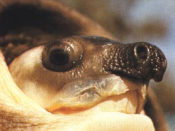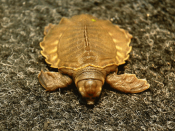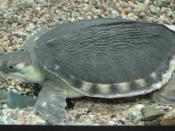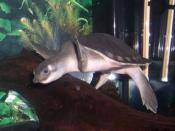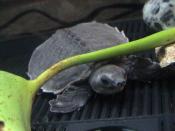REPTILIA: TESTUDINES: CARETTOCHELYIDAE CARETTOCHELYS INSCULPTA ______________________________________________________________________________________________________________________
�
Catalogue of American Amphibians and Reptiles.
Amelingmeier, Amber. 2008. Carettochelys insculpta.
Carettochelys insculpta
Fly River turtle, the Pig-nosed turtle.
Carettochelys insculpta . Ramsay,1886.
Content. Is the only surviving member of its genus and the family Carettochelyidae (IUCN 2004).
Definition. Carettochelys insculpta is a moderately large aquatic turtle that can reach up to 60 cm in carapace length and up to 22.5 kg in weight. Instead of scutes, the carapace is covered with a leathery skin and is relatively deep. A median keel is present towards the back of the carapace. "The peripheral bones are complete and well-developed, so there is no flexible shell margin" (Georges & Rose 1993). The color ranges from dark grey through olive-grey to brown. The hatchlings also posses a small rounded projecting center keel and a jagged margin on the sides of the carapace. The upper part of the head is grey that has a noticeably white spot behind the eyes.
The spot from time to time gets paler with age and may seem to be inexistent. Another spot can be found on the underside of the chin which is much darker than the spot found on the Carettochelys insculpta's head. The chin itself also has a cream to light brown color. The jaws are big with a strong grip. The tongue is pink and fleshy and the eyes have a black pupil and a black iris with a dark blue edge. One other distinguishing feature of the turtle's head is its prominent nose. A soft, trunk-like snout with two large openings at the end has given the turtles its name: Pig-Nosed Turtle (Ernst & Barbour, 1989).
FIGURE: Distribution of the Carettochelys insculpta. Link: http://www.chelodina.com/Map_australasia_carettochelys.jpg
FIGURE. A picture of a Carettochelys insculpta that has its head retracted into its carapace. Link: http://www.australianportraits.com/aquarium/topics/creatures/tortoises/images/pic55.jpg
Breeding. Sexual maturity in males is reached after 14-16 years having a carapace length of about 30cm. Females reach sexual maturity later (20-22 years), by that time the females have reached a carapace length of 30-34cm. The growth rate before maturity is estimated to about 15 years for pig-nosed turtles from the Daly River. "This is the time needed for a hatchling to grow from 15mm to 300mm" (Cann 1998).
Within Australia and New Guinea the Carettochelys insculpta's clutches are deposited during the dry season from July to October. Females lay up to two clutches per year, normally containing 7 to 19 eggs. The females lay eggs only every second year, skipping a year between clutches. The Eggs are laid at night within sandy grounds. Unlike marine turtles, Carettochelys insculpta does not use the front flippers in nesting; instead the hind limbs are used. Females come ashore one at a time to explore the nesting area. They return to the water after a short time. This is repeated by other females and only test holes are dug, abandoned after a short time. Then the females come ashore actually to lay their eggs which are 50cm to 5m above water level and the hole being about 22 cm in deep. It still isn't known why such large animals that have almost no terrestrial predators show such cautious behavior (Georges A.,Doody S.,Young J., Cann J. 2000).
Diet: Carettochelys insculpta are opportunistic feeders, largely omnivorous, but tend to consume a higher ratio of herbivore food. They feed on fruits, flowers, leaves and roots off of the riverbank vegetations. The fruits of figs and pandanus that fall into the water are regularly eaten. The pig-nosed favorite food item is the ribbon weed (Valisneria spiralis) which grows in the water. Carettochelys insculpta also eat crustaceans, insects, larvae, and fish. A large range and amount of food is found throughout the rainy season, when vast majority of the habitats are flooded (Groombridge, 1982).
FIGURE: Picture taken of Carettochelys insculpta two hours after hatching. Note that the marginal scutes are already flat. Link: http://www.carettochelys.com/literature/visser_2005_2.htm
Distribution. The distribution of the Carettochelys insculpta is limited to lowland Papua New Guinea (New Guinea and the Indonesian province Irian Jaya) and Northern Australia (Georges & Kennett 1989).
Habitat. The Pig-nosed turtle likes to occupy bodies of water that contain water year round such as larger bays, estuaries and rivers especially large wholes and lagoons on river systems. Most Pig-nosed turtles have been seen within waterways having sand and gravel bottoms covered with silt, with an averaging depth of six feet. These waterways are normally abundant with trees. Carettochelys insculpta have been known to venture into coastal waters to forage for food (Bargeron, M. 1997).
Fossil Record. Miocene epoch (Glaessner, 1942).
Nomenclatural History. Analyzing cladistics of both the morphological and molecular characteristics have placed the Carettochelyidae as a close relative to the Trionychidae, the soft-shelled turtles. The skeletal characters that had identified the carettochelyids and trionychids as a monophyletic group had consisted of the union of the left and right premaxillae, lack of junction between the carapace and plastron, and three or less clawed digits. The Carettochelys insculpta was initially described as a Pleurodire (Ramsay, 1886) and had said to be among both the freshwater turtles and the sea turtles (Ramsay, 1886). The genus was then given to a new family, the Carettochelyidae (Boulenger, 1887) and Baur (1891) was the one who had moved Carettochelys, as well as the family Carettochelyidae, into the Cryptodires. Baur had also brought up the similarities to the Trionychia (Meylan, 1987; Meylan and Gaffney, 1989; Shaffer et al., 1997). However recent genetic evidence suggests that Trionychoidea is an invalid group, and that Trionychoidae is a distinctive lineage that split off very early from other turtle (Krenz et al 2005)
Literature Cited
Anders G.J. Rhodin, Vagi R. Genorupa (1999). Conservation Status of Freshwater Turtles in Papua New Guinea Asian Turtle Trade, Chelonian Research Foundation, page 129-136
Bargeron, M. 1997. The pig nose turtle, Tortuga Gazette, Volume 33, No.3
Baur, G. 1891. On the relations of Carettochelys, Ramsay. American Naturalist 25:631-639.
Cann, John, 1978. Tortoises of Australia. Angus and Robertson Publishers, Sydney, Australia.
Cann, John,1998.Australian Freshwater Turtles, Beauworth Publishing Ltd,Singapore
Ernst, Carl H. and Roger W. Barbour, 1989. Turtles of the World. Smithsonian Institution Press, Washington DC.
Frair, W (1985).The enigmatic plateless river turtle, Carettochelys, in serological survey, Journal of Herpetology, Vol.19, No.4, pp 515-523
Georges A. (1987).The pig nose turtle Warradjan, Australian Natural History, Vol.22, No.5
Georges, Arthur and Kennett, Rodney. 1989. Dry-season Distribution and Ecology of Carettochelys insculpta (Chelonia : Carettochelydidae) in Kakadu National Park, Northern Australia. Aust. Wildl. Res., 16, 323-35
Georges, Arthur and Mark Rose, 1993. Conservation biology of the pig-nosed turtle. Chelonian Conservation and Biology 1: 3-12, 1993
Georges A.,Doody S.,Young J., Cann J. (2000) The Australian Pig-Nosed Turtle. Robey, Canberra
Glaessner M. F. 1942. The occurrence of the New Guinea turtle (Carettochelys) in the Miocene of Papua. Rec. Aust. Mus. 21:106-109.
Groombridge, B. 1982. I.U.C.N. Amphibia-Reptilia Red Data Book. Part 1. Testudines, Crocodylia, Rhynchocephalia. I.U.C.N. Publ., Gland, Switzerland.
IUCN (2004): 2004 IUCN Red List of Threatened Species.
Krenz, James G. et al. 2005. Molecular phylogenetics and evolution of turtles. Molecular Phylogenetics and Evolution 37, 178-191.
Meylan, P. A. 1987. The phylogenetic relationships of soft-shelled turtles (Family Trionychidae). Bulletin of the American Museum of Natural History 186:1-101.
Meylan, P. A., and E. S. Gaffney. 1989. The skeletal morphology of the Cretaceous turtle, Adocus, and the relationships among the Trionychoidea. American Museum Novitates 2941:1-60.
Shaffer, H. B., P. Meylan, and M. L. McKnight. 1997. Tests of turtle phylogeny: molecular, morphological, and paleontological approaches. Systematic Biology
6:235-268.
Webb, G.J.W. et all, (1986). Nest, eggs and embryonic development of Carettochelys insculpta (Chelonia: Charettochelidae) from northern Australia. J. Zool. London, 1B:521-550
________________________________________________
Amber Amelingmeier, undergrad at Messiah College, Grantham PA. Working on bachelor's degree in Biology and a minor in Environmental Science.
_________________________________________________
�

